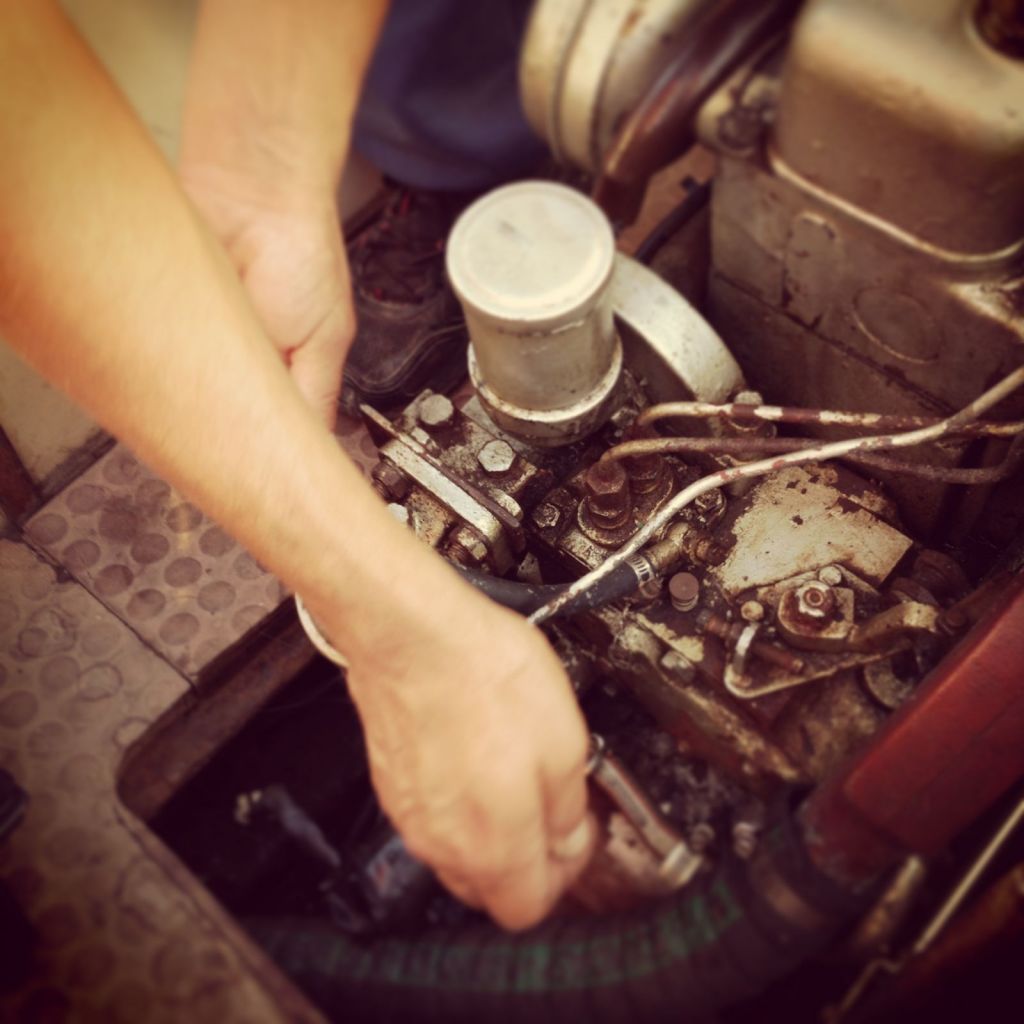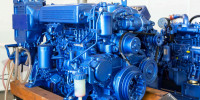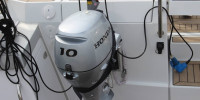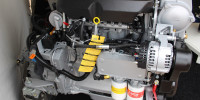How Much Does a Boat Engine Oil Change Cost?
Changing your oil on schedule is important for every four-stroke engine. Most manufacturers recommend every 100 hours of runtime and at the end of the season before winter storage. But what will this cost you each time?
If you change your oil yourself and have all the tools, it will cost you from $40 to $70 for an average sized inboard diesel engine. Paying someone else to do it may add another $100 or more to this cost. Outboard engines may cost a little less.
It's not a tough job on most boats, doing itself can save you a lot of money. So let's get into the details on the costs and some savings.

Cost Breakdown
Where you live, current oil prices, and the size of your engine will all affect your final bill every time. With a little upfront spending, some time, and a little careful shopping, you can cut that a bit.
Oil & Filters
Check your engine manual for the grade and weight of oil you need, as well as how many quarts or liters it requires. Oil is available in mineral and synthetic varieties. Mineral is oil from the ground. Synthetic oils often have longer life and better lubricating characteristics for older engines.
When selecting the correct oil, use only one brand and type of oil for each oil change. Oils have different additives, and different manufacturers use different compositions. Mixing brands or types of oil on a single oil change may reduce their effectiveness if additives aren't compatible with each other. Changing brands between oil changes is less of a problem, as there's little of the old oil and additives left after you drain the engine. So buy enough for the complete oil change and don't make up shortages with odds and ends.
Very few four-stroke engines require "marine" engine oil - it's the grade and weight which matter. If you buy the correct grade and weight at an auto store, you can save money. Buying a gallon jug is cheaper than quarts, and if you have a big engine, bigger jugs are even cheaper. Though these can be awkward to use in tight spaces, so they may not be worth the savings.
Oil weights and categories: Oil is graded by "Weight" as well as API (American Petroleum Institute) "Rating" or "Service." To find out the details, look for the round "donut" on the jug of oil, and it will tell you all you need to know.
Weight rating is a number, like 10W-30, or SAE 30. This refers to the viscosity of the oil, how thick it is and how easily it flows. Higher numbers are more viscous. If there are two numbers with a dash and a W, the first number refers to the winter (low temperature) viscosity in a multi-grade oil.
The donut also tells you if this is for gasoline or diesel engines. API service codes starting with "S" are always for gas engines, and "C" is for diesel. Higher service rated oils are always backwards compatible with older engines, but be careful using older oil with brand new engines..
When changing your own oil, dispose of the used oil responsibly. Do NOT pour it in the water or bury it somewhere. Most marinas have used oil facilities, and many service stations will accept used oil. In the worst-case scenario, you may have to pay a small fee to accept your oil, but this is uncommon.
Your engine manufacturer sells branded oil filters for your engine model. These are fine, but there are often third party filters which are just as good and may be a fraction of the cost. Look for a "crossover" chart to reference your OEM part number against other filters to make sure it's the right filter, or ask someone at a marine parts supplier if they have alternatives to the original engine brand. Using an $8.00 third party filter instead of the $35.00 filter with your engine maker's logo on will save you lots and pose no risk to your engine.
Tools
To change the oil on your engine, you'll need to get the oil out, get the oil filter off, and dispose of the oil. The primary tools you need for an oil change are a onetime expense, but they will pay for themselves quickly.
- An oil extractor. Most boat engines won’t drain from below, so you’ll need a pump to pull the oil out - usually through the dipstick. Cost runs from $20 for tiny handheld or electric pumps with no tanks attached, to several hundred dollars for larger pumps with reservoirs for used oil. Integral tanks are easier to work with, faster, and less messy.
- If you don't have a reservoir on your pump, you'll need an oil pan or bucket to collect the used oil. If you can make it work, the oil jugs from your last oil change are free and disposable with your oil.
- An oil filter wrench to get the tight filter off. Available at any auto parts store, adjustable wrenches fit a range of sizes and cost less than $15.00.
- Funnels. You'll want a clean funnel to fill your oil, and transfer used oil to jugs for disposal. These aren’t expensive.
- Optional - oil change pads. Disposable oil change pads make the job a lot neater than catching spills on rags or cardboard, since they can absorb spilled oil before it can run off the edge. Save money buying a large package of these online or from an auto parts store, where they can cost less than $1.00 a sheet. One sheet can be good for several oil changes if you don't spill too much on it.
- Rags. It can get messy. Red shop rags work really well, but absorbant rags from old t-shirts and cotton clothes also will do.
You can get set up to change a small engine for $40 to $100, and a larger engine for $200 to $300.
Hourly Labor
If you hire someone to change your oil, it adds considerable cost. Marine technicians charge from $55 an hour to $125 or more, and may have a minimum number of hours for minor jobs. And they may charge for travel time to and from your boat. When budgeting for an oil change, get a quote from your technician before you make an appointment. Changing the oil may only take an hour or two, but don't be surprised if the estimate includes more time.
There is a definite convenience factor in paying someone to handle these tasks, since they can be time-consuming and messy and it's not how you want to spend your weekends. Balance the costs out against your time - since it's only once or twice a season for most boaters, many opt to pay the extra and not do it themselves.
Outboard Oil Changes
Changing an outboard usually costs less than inboards. They're often smaller and use less oil, and they're easier to get to since they aren't inside the boat in a tight engine compartment.
Outboards run at higher RPMs than diesels and large gas engines, and may require more specialized marine grade oils because of the additives. Always check your owner's manual for specifics.
Two stroke outboard engines do not require engine oil changes. The oil mixed in with the fuel is their only lubrication, and there is no oil filter. They still need lower unit changes.
Portable Outboards
Small outboards are easiest to do on a sawhorse or engine cart. It's easier to do with the engine off the boat since you can't spill any oil in the water, and you don't have to work leaning over the water.
Even the largest portable outboards use less than two quarts of oil in a change, and the smaller low HP miles may use well under a quart and name-brand filters are small and relatively inexpensive.
Large Outboards
Very few sailboats sport outboards over 25 horsepower, but for those few that may (like the MacGregor 26 series) they are best changed with the boat out of the water if you can trailer it. Oil and filter costs may be more in line with smaller inboard engines.
Lower Unit Oil
It's often forgotten, but ALL outboards have an additional oil change - even two-strokes. Check your owner’s manual for the period, but the lower unit has an oil reservoir that you should change seasonally, at a minimum. Your costs may run $10.00 to $20.00 for a do-it-yourself change.
You can use the same drain pan to catch the oil for disposal, but you may need new o-rings for the drain plug and a reusable fitting to fill the oil (about $25.00). Lower unit oil is a special, higher viscosity oil specifically for gears. As of this article, it costs about $15.00 for a quart. Most small outboards use less than a pint of oil.
If you hire someone to change the crankcase oil, you might as well have them do the lower unit, especially if they have a minimum labor charge to visit your boat.
Did you find the answer to your specific question?
👍 1 👎 0



Leave a comment